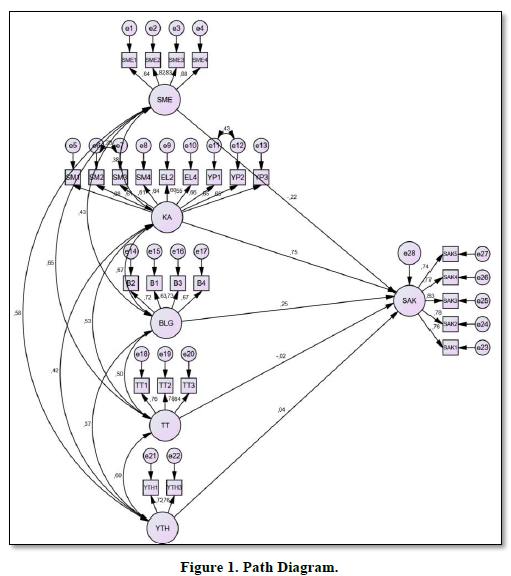398
Views & Citations10
Likes & Shares
With the pandemic, identifying the factors that affect the consumer's OFD purchasing decision will allow both to allocate a sustainable relationship with existing consumers and to acquire new customers. The present study aims to determine these factors that influence a consumer's OFD purchase decision. The structure of the paper is as follows. The second section discusses the theoretical model and hypotheses. The third section explains the research method and describes the data, and the fourth section evaluates the results. The final section presents the resulting implications and conclusion.
Theoretical framework and hypotheses
In the literature, different theories and models have been used to investigate the factors that affect consumers' service adoption, perceptions, intentions and purchasing decisions regarding OFD services. For this purpose, the studies conducted in the related literature in order to analyze the factors that affect the consumer's adoption of OFD service are mostly based on the Technology Acceptance Model (TKM) (Alagöz and Hekimoğlu, 2012; Arı and Yılmaz, 2015; Dilek and Öztürk, 2021; Jun, Yoon, Lee et al. Lee, 2022; Tomaş, 2014; Tribhuvan, 2020). In the studies in the literature, not only the TAM model has been utilized, but also the Planned Behavior Theory (TBP) (Amin , 2021; Chen, Liang, Liao, & Kou, 2020; Deepika and Arun, 2021; Tran, 2020), Extended Planned Behavior Theory (Kılıçalp & Özdoğan, 2019; Prayesto, 2021), Unified Technology Acceptance and Use Theory (UTAUT) (Alalwan, 2020; Muangmee, Kot, Meekawkunchorn, Kassakorn & Khalid, 2021), Extended Integrated Technology Use and Behavior Model (UTAUT2) have been used. In addition, models developed based on the literature were also tested in the relevant literature (Armağan and Eskici, 2019; Brewer and Sebby, 2021; Chai and Yat, 2019; Hong, Choi, Choi and Joung, 2021; Kapoor and Vij, 2018; Zhao & Bacao, 2020).
In a study conducted in Jordan using a conceptual model based on the UTAUT model, they discovered that, together with the Covid-19 Pandemic, online reviews and ratings, performance expectation, hedonic motivation, and price had an impact on consumers' intention to use OFD services and intention to use it consistently (Alalwan, 2020). In another study within the framework of the UTAUT model, it was found that performance expectation, effort expectation, social impact, time saving, task-technology compatibility, perceived trust and perceived safety factors affect the consumer's intention to use OFD services during the Covid-19 Pandemic period (Muangmee et al., 2021). As a result of their study using an expanded UTAUT2 model enriched with the information quality factor in order to determine the factors affecting the intention of consumers to use OFD services continuously in Korea, they discovered that habit has the most effect on the intention to use the OFD service (Lee, et al., 2019). In addition, they concluded that habit has performance expectancy and social impact, respectively, but that the information does not have a direct effect on the intention to use it continuously.
While Yeo, Goh & Rezaei, (2017) supported the structural relationship between convenience, convenience motivation, hedonic motivation, price-saving orientation, time-saving orientation, consumer attitude, and behavioral intention to purchase; (Cho, Bonn & Li, 2018). discovered that the accuracy and timeliness of the information provided by the platform or restaurant is the most important factor in OFD, which they define as the reliability factor. At the same time, food variety, price and reliability are the factors affecting the attitudes of single-person households, while convenience and food variety come to the fore in multi-person households. On the other hand (Tomaş, 2014). stated that the variety of products, the fact that the platform has comments and evaluations, and the fact that consumers facilitate access to restaurants around them are the reasons for consumers to use OFD platforms (Tran, 2020). carried out in Vietnam to analyze the effects of perceived food safety, hygiene of food delivery service and behavioral intention on attendance behavior, in addition to the assumption that subjective norms and social isolation have a positive effect on behavioral intention and continuation behavior on the basis of PDT with the Covid-19 Pandemic. Food delivery hygiene, perceived food safety had been found a positive effect on intention to use OFD. Chai and Yat (2019), on the other hand, concluded that time saving had the most effect on the intention to use the OFD services while the other factors were convenience and privacy-security factors, respectively.
Cai & Leung, (2020) aimed to analyze how the interaction of fictional mindsets and message frames influences OFD purchase intention during the Covid-19 Pandemic era. They found that promotional-framed messages were more effective on consumers' purchase intentions when paired with a "how" fictional mindset in dense regions, in New York, where the Covid-19 Pandemic was intense, and California, where it was infrequently seen, whereas in mild pandemic regions, "why" was framed with a fictional mindset. They discovered that messages were more effective on consumers' purchase intentions.
According to Saad, (2020) the success of OFD services is directly influenced by delivery time, service quality, pricing, and the state of the food when it is delivered. Researchers in several nations have given OFD a great deal of attention (Ali et al., 2021; Bates et al., 2020; Chen, 2020; Daim, 2013; Dsouza and Sharma, 2020; Lee, 2017; Li; 2020; Mehrolia et al., 2020; Troise, 2020). According to literature on technology adoption, a person's attitude, perceived usefulness and ease of use, speed of the website, quick response times for online services, and the friendliness and caliber of the staff all play a role in whether or not they adopt technology for OFD services (Lee, 2017, Daim, 2013).
Previous studies have shown that convenience motivation and post-usage usefulness (Yeo et al. 2017 Brewer & Sebby, 2021), pleasure and trust (Jun, Yoon, Lee, & Lee, 2022), hedonic values and utilitarian (Chen, 2020), performance expectancy, optimism, habit, and mindfulness (Gunden et al., 2020), congruity with self-image and innovativeness (Ali et al., 2021), menu information and visualization (Akgün& Zerenler, 2021; Brewer & Sebby. 2021), lifestyle adaptation (Belanche, Flavian & Rueda,2020). Trust, convenience, and social impact (Chotigo & Kodono, 2021; Zhao & Bacao, 2020). exert a positive effect on intention of using the OFD services.
The factors affecting the Thai consumers' decision to use OFD service after the Covid-19 Pandemic were identified as Age, purchase frequency, affective and instrumental attitudes, perceived advantages, perceived threat, and product participation were found to account for 58.5 percent of the variance in respondents' choice of OFDs during the COVID-19 outbreak, according to Mehrolia, 2020). Furthermore, Ali, (2021) and Mehrolia & Alagarsmy ve Solaikutty, (2020) discovered a strong and unfavorable association between OFD service intents and feelings of fear and discomfort.
Comfort Zone
It is possible to define the comfort zone as all of the situations in which the individual feels safe and comfortable by identifying the problems that he may encounter and producing solutions for the related problems. With the Covid-19 Pandemic, consumers have created comfort areas where they feel at least at risk and lead a life away from the contagion of the epidemic with the least effort. In these comfort areas they have created, consumers can order online at any time they want (Deepika & Arun, 2021) by paying attention to the social distance rule (Hacıalioğlu & Sağlam, 2020). At the same time, they reduce the possibility of dissatisfaction with the products by reading consumer comments and scores (Kim, 2020). In this context, consumers can associate comfort zone factor with social distance, convenience and comments & ratings with the Covid-19 Pandemic in the online environment.
The social distance rule, which is one of the most important issues in the fight against the epidemic; It has also deeply affected the restaurant industry. Social distancing refers to actions that reduce the likelihood of transmission of COVID-19 by reducing physical interaction between individuals or groups (WHO, 2020; Deepika & Arun, 2021). Due to the COVID-19 pandemic, social distance has also reshaped the daily lives and consumption practices of individuals (Amin et al., 2021).
With the Covid-19 Pandemic, it has been researched by the limited researches in the literature that while social distance is effective in the behavior of consumers, it also positively affects their intention to continue using OFD service (Amin et al., 2021, Deepika and Arun, 2021). In addition, it has been discovered by previous studies in the literature that consumers who choose to be online during the process where restaurants continue only as a take-out or take-out service, after the bans are lifted, they turn to online in order to alleviate the virus by maintaining social distance (Deepika & Arun, 2021; Kirk & Rifkin, 2020; Sheth, 2020; Wang, et al., 2021).
The biggest advantage of using OFD services; It is the transformation of order taking / placing processes to become simple, free from misunderstandings for both consumers and businesses (Gavilan, Cejodo, Lores, & Navarro, 2021). At the same time, real-time connection to OFD platforms provides speed and flexibility to the user. Existing empirical studies have found that convenience is a strong factor in consumers' reasons for OFD services (Brewer and Sebby, 2021; Chai& at, 2019; Cho, 2018; Deepika & Arun, 2021). One of the features provided by OFD service platforms has given consumers the opportunity to create their own feedback with comments and ratings (Alalwan, 2020). Consumers who ordered food online through Yemeksepeti.com in 2020 made 9.5 million comments and 5.4 million points (Papuççiyan, 2020). Ha, Park & Park, (2016) stated that as a result of their research with 294 participants, comments and ratings have a significant effect on consumers' preferences in choosing both online and offline restaurants. Considering the above-mentioned issues, the following hypothesis has been developed by associating the comfort zone with social distance, convenience and comments&points features in the online environment.
H1: With the Covid-19 Pandemic, the comfort zone positively affects the purchasing decision of OFD service.
Hygiene of OFD service
During the Covid-19 Pandemic process, couriers take precautions such as wearing masks and gloves, using disinfectants, disinfecting delivery bags and using contactless delivery while delivering orders (Amin, 2021; WHO, 2020). Amen, (2021) associates the term “hygiene of the OFD service” with the courier, defining it as the ability of the courier to keep himself and the food clean. In a similar way, Chandrasekhar, Gupta & Nanda (2019) state that since the hygiene of the restaurant cannot be observed by the consumer in OFD, the courier's image of hygiene will be associated with the degree of hygiene of the restaurant. With the Covid-19 Pandemic, it is likely that the image of being hygienic that the couriers will display during the food delivery service will have a positive impact on their decision to use OFD service platforms. Therefore, the following hypothesis has been developed.
H2: With the Covid-19 Pandemic, the hygiene of the OFD service positively affects the purchasing decision of OFD.
Contactless delivery
Various online applications have also brought certain updates to their services, based on the statements that individual contact should be reduced as much as possible in order to prevent the spread of the epidemic. One of these features has been the contactless delivery option. Consumers are encouraged to use contactless payment or online payment options to maintain social distance and minimize physical contact (Amin, 2021). At the same time Mehrolia et al. (2020) stated that the perceived risk at the process of OFD service negatively affects the probability of using this service. Zhao & Bacoo, (2020) discovered that the contactless delivery option positively affects the consumer's intention to use OFD service. The following hypothesis has been developed in order to analyze the effect of the contactless delivery application, which has become a sought-after feature with the Covid-19 Pandemic, on the consumer's purchasing decision of OFD service.
H3: With the Covid-19 Pandemic, the availability of contactless delivery option positively affects the purchasing decision of OFD services.
Healthy Menus
Increasing health awareness with the epidemic has also led to an increase in the demand for the use of healthy and natural products (Demirdelen and Çiftçi, 2021; Fanelli, 2021; Galanakis, 2020; Zwanka & Buff, 2020). With the Covid-19 Pandemic, the increasing interest of consumers in healthy menu contents has led to the necessity of renewing some menu components by including recently trending products (Cömert & Yeşilyurt, 2021). The study carried out by Bucak & Yiğit, (2021) with the Covid-19 Pandemic is the first research in the literature that examines the effects of the epidemic on the food and beverage sector and the changes in their behavior with the chefs working as managers through online interviews. Chefs stated that the change in the sector will be permanent, menu planning processes will be shaped according to local and healthy products, and food safety will be given maximum importance. However, with the Covid-19 Pandemic, this factor has not been examined in the literature on OFD, although chefs think that consumers will turn to healthy menus. Therefore, the following hypothesis has been developed:
H4: With the Covid-19 Pandemic, menus with health claims positively affect the purchasing decision of OFD.
Information
Platforms that offer OFD services provide consumers with comprehensive, detailed and up-to-date information about menus and their contents. In addition to the menu information, it also gives the consumer the opportunity to follow the status of their order (Alalwan, 2020). In the related literature, it has been stated that the density and currency of the amount of information available increases the interaction of consumers with OFD platforms (Peters et al., 2016). As a result of their research, Kapoor & Vij, (2018) discovered that the information provided by OFD platforms has a positive effect on the consumer's order and payment. However, research has shown that consumers expect more than a menu from OFD platforms, the nutritional values, ingredients and cooking methods of the products (Peters and Remaud, 2020). Brewer & Shebby, (2021) discovered that menu information increases the consumer's desire for the product during the Covid-19 pandemic. As a result of the study carried out in India by Bagla & Khan, (2017) it was observed that consumers prefer platforms that provide detailed information about menus. In addition to these issues, it has been emphasized that the quality of information and knowledge structure in OFD applications are effective in increasing the loyalty of users during the Covid-19 pandemic period (Prasetyo et al., 2021). In the light of this information, the following hypothesis has been developed,
H5: With the Covid-19 Pandemic, information about menus and contents of OFD applications positively affects the consumer's purchasing decision.
MATERIALS AND METHODS
A self-administered questionnaire was developed based on a comprehensive review of previous literature. At the beginning of the questionnaire, a definition of OFD was presented. There were two main sections to the survey. The first section included questions asking the socio-demographic information of the respondents. The second section of the questionnaire was comprised of items measuring study constructs, including KA, TT, BLG, SME, YTH and SAK using a 5-point Likert scale (1 being “strongly disagree”; 5 being “strongly agree”). Three demographic inquiries were performed of the participants in the first section. The items of scales used in the study and the studies in which the questions were included in the study are as listed in Table 1.
A pilot research involving 20 people was carried out to determine the validity of the questionnaire and gauge how well the items were understood. They were all university graduates, 11 of them female and 9 of them male, with ages ranging from 31 to 58. They were made aware of the study and participated voluntarily. An online questionnaire was used as a data collection method in the research. The online survey was administered in December 2021 and answered by 469 respondents. At the end of the section, where the demographic information of the participants was collected, the question “have you ever used OFD services?” and “when was the last time you used OFD services?” were included. The surveys of the participants who answered “No” or “Before the Pandemic” to these questions were automatically terminated. For this reason, the survey of 51 participants in total was terminated, as 42 of the 469 participants stated that they had never used OFD services before and 9 of them stated that they only used OFD services before the pandemic. As a result, 418 questionnaires were evaluated and included in the analysis. The population of the research consists of consumers who have used OFD services at least once during the pandemic period. When the probability of occurrence or non-occurrence of events is calculated as 0.5 in cases where the number of individuals in the population is not certain, the sample size is calculated as 384 with a confidence level of 95 percent and a margin of error of 0.05 samples (Kurtulmuşoğlu & Atalay, 2019). In this direction, it can be said that the sample size of 418 reached in the study is sufficient at the 95 percent confidence level. Data analysis was performed using statistical software package SPSS 26 (Statistical PackagefortheSocialSciences - IBM®) and AMOS 24 program. Structural equation modeling used in this research, which allows the relationships between direct and linear variables to be measured through a single model, is a statistical method that is increasingly used in scientific studies in the field of social sciences (Civelek, 2018). SEM allows to test the hypothesis about the relationships between the observed variables measured in the data collection process and the latent variables measured by connecting them to the observed variables since they cannot be measured directly.
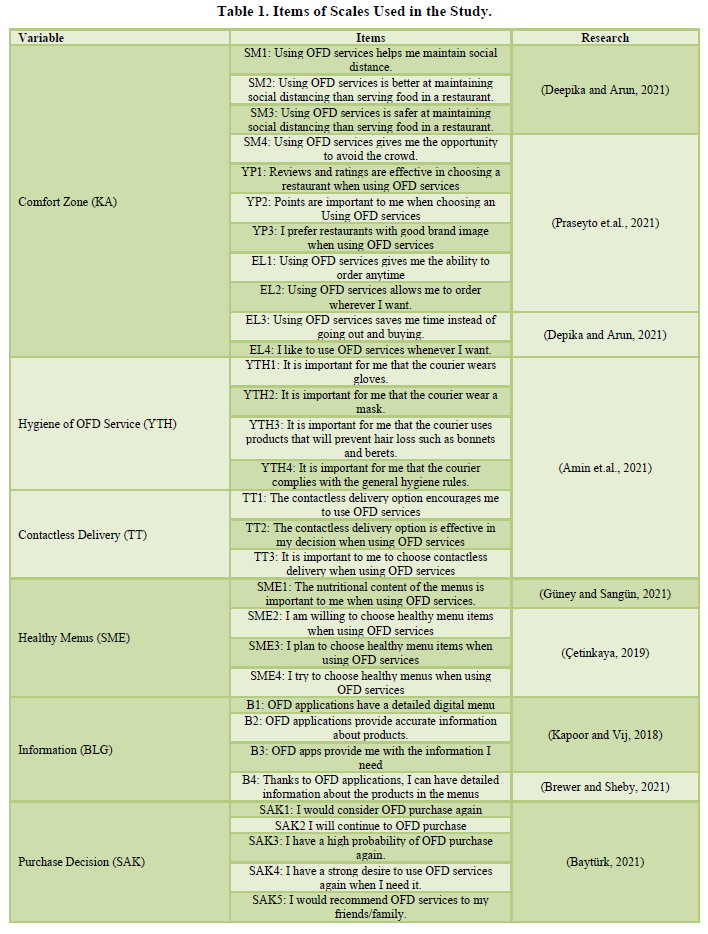
RESULTS
Frequency and percentage values for demographic characteristics, time of using OFD services are shown in Tables 2 & 3.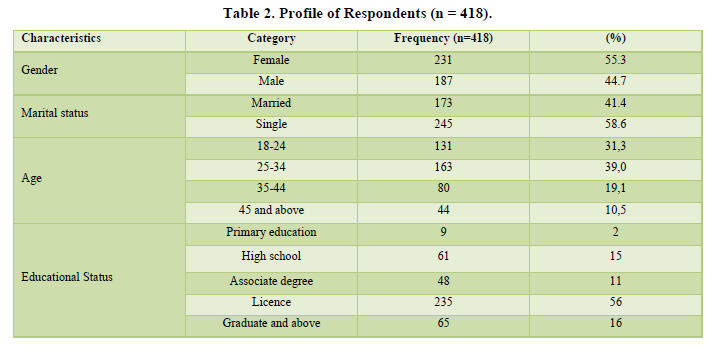

To determine the reliability of the scales, the coefficients of the Kaiser-Meyer-Olkin (KMO) test (0.910> 0.5) and Bartlett’s test of sphericity (p = 0.000 < 0.01) were identified (Table 4).

Principal component analysis with quartimax rotation was then used. As a result of the factor analysis, five dimensions were obtained for respondents’ evaluations regarding OFD services during the pandemic period namely comfort zone, contactless delivery, healthy menu, hygiene of OFD Service, information. In terms of reliability analysis, Cronbach’s alpha value was determined as 0.926. Each dimension’s factor loadings and internal consistency values are provided in Table 5 the variables YTH2, YTH4, EL1 and EL3 variables were excluded from the analysis because they were loaded on more than one factor with factor values very close to each other.
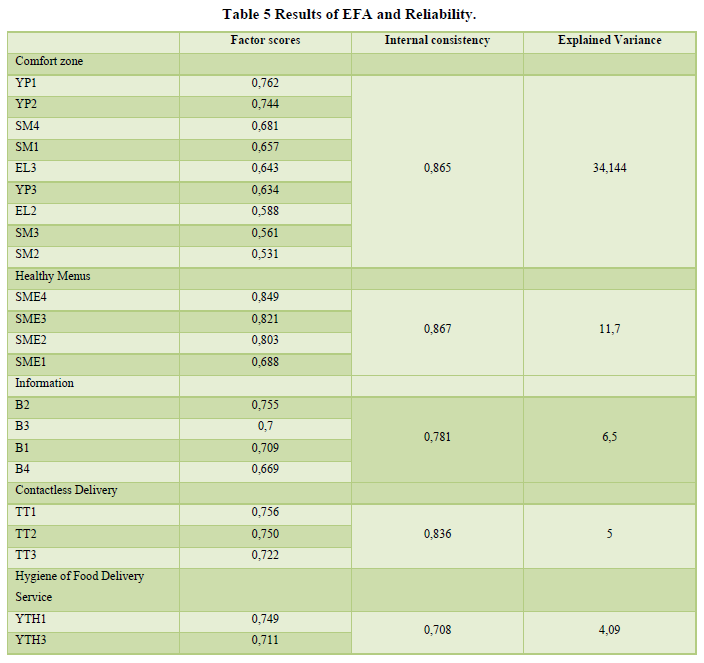
How well the model explains the data obtained using SEM is determined by the goodness of fit indices and threshold values. The stage in which the decision to accept or reject the model is made is goodness of fit tests and the threshold values are not exceeded (Ayyıldız & Cengiz, 2006). For this purpose, Chi-square, CMIN/DF, NFI (Normed fit index), TLI (Tucker-Lewisindes), CFI (comparative fit index) and RMSEA (approximate root mean square error) indices are used (Table 6). These findings suggested that the hypothesized model fitted the data well and the model had an appropriate fit SEM analysis confirmed that the sample was large enough for the structural model and that the relevant model was statistically significant (Figure 1). The next step is to test the hypotheses by interpreting the magnitudes of the correlation degrees based on the path coefficients showing the degree of relations between the latent variables.
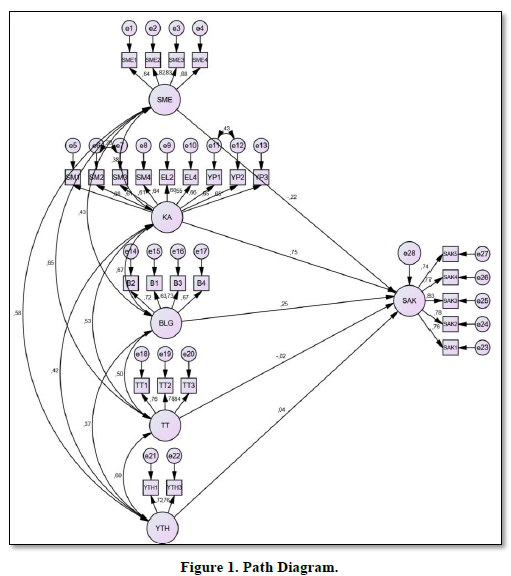
According to the results of the Path Analysis in Figure 6.2 and the revised structural equation model in Table 7 the p values calculated for the significance of the relationship between the comfort zone & purchasing decision and information &purchasing decision & are less than 0.001 (p=***< 0.05) and the standardized regression coefficients between them are 0.75 and 0.24 respectively i.e. H1 and H5 are accepted. It is seen that the p value calculated for the significance of the relationship between healthy menus and purchasing decision is less than 0.001 (p=***<0.05) with the standardized regression coefficient between healthy menus and purchasing decision (-0.21). Considering this value, there is a negative relationship between healthy menus and purchasing decision i.e. H4 is rejected. As p values calculated for the significance of the relationship between the hygiene of OFD service & purchasing decision and contactless delivery & purchasing decision are greater than 0.1 so H2 and H3 could not be supported.
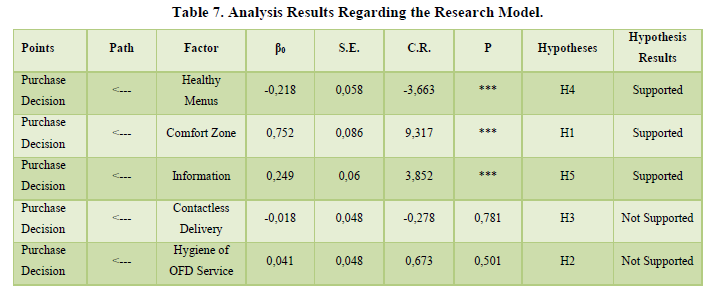
DISCUSSION
Due to the spread rate and severity of the Covid-19 Pandemic, countries have entered the struggle process by taking radical measures. The protocols followed and the measures implemented in this process have greatly changed human interaction and approach, and have caused people's daily lives to be deeply affected (Kirk and Rifkin, 2020; Laato, et al., 2020; Sheth, 2020; Yuen et al., 2020). From this change experienced, the axis of consumer behavior and consumer demands has also changed (Hussey, 2021). In this process, the procedures followed by governments have not only changed consumer behavior, but also caused businesses to adapt their business methods (Kim et al., 2021). The food and beverage sector have also suffered heavy damage due to these sanctions. In this process, where the sector has difficulty in turning its economic wheels, OFD service has turned into a lifeline for the sector in this process (Iybar, 2020).
ACKNOWLEDGMENTS
As a result of the SEM analysis, it has been shown that the comfort zone factor has the most and positive effect on the consumer's purchasing decision with the Covid-19 Pandemic, it was seen that it was supported in the same direction by existing studies (Brewer and Sebby, 2021; Kimes, 2011). From this point of view, it is possible to say that the opportunity of consumers to order from anywhere at any time while staying in their comfort zone has a positive effect on their decision to use OFD service. Because of this factor, which affects consumers' decision to use OFD service, it can be recommended that restaurants provide service to consumers in wider time zones, even if they are not online 24/7.
Before the Covid-19 Pandemic, mostly young consumers wanted what they wanted "when they wanted it", but with the Covid-19 Pandemic, this demand has spread to a much wider customer base. In this context, it can be recommended that businesses turn to cloud kitchens in order to respond to more OFD services requests in a wider time frame. Cloud kitchens; are kitchens where different restaurants that only accept OFD through their online apps and websites share common space to make their food and service customers through delivery (Affility, 2021). These are also known as virtual kitchens, dark kitchens, commercial kitchens, ghost kitchens and cyber kitchens, have grown rapidly due to the fact that they satisfy consumers' social distance sensitivity by keeping human interaction at a minimum level during the Covid-19 period (Affility, 2021). While cloud kitchens attract the attention of businesses due to lower costs and higher profit margins, it is predicted that most of the meals consumed at home will be prepared by cloud kitchens in the near future (Adams, 2020). It is recommended that businesses consider the cloud kitchen option in order to respond to the comfort zone sensitivity of the consumer and to catch the cloud kitchen trend that is predicted to be experienced in the near future and to get a faster reaction in possible pandemics.
As a result of the SEM analysis, it was determined that the information had a positive effect on the OFD services purchasing decision of the consumer. In this context, it is possible to say that the same conclusion has been reached with previous studies in the literature (Bagla and Khan 2017; Brewer and Shebby 2021; Kapoor and Vij, 2018; Lee et al., 2019; Praseyto et al., 2021). It is recommended to keep the products in their online menus and their stock status, product contents, average delivery time up to date. In order to achieve this, businesses need to regularly update the information and timelines they provide. The fact that businesses keep their information up-to-date by checking frequently will both positively affect the purchasing decisions of consumers in the online environment and minimize the dissatisfaction that may arise due to erroneous information.
A negative relation was found between healthy menus and OFD services decision contrary to expectations. Contrary to the expectation of the chefs in the relevant literature that the consumers will turn to healthy products with the Covid-19 Pandemic (Bucak and Yiğit, 2021; Cömert & Yeşilyurt, 2021). one of the reasons why a negative relationship was found online may be due to the fact that most of the participants are single and young. For this reason, it is recommended that businesses whose target audience is young people in online food ordering should not include healthy menu messages in their communication strategies.
Contrary to previous literature support, the positive relationship assumptions between hygiene of OFD service & contactless delivery and purchasing decision of OFD services could not be supported statistically.
CONCLUSION
There are some limitations in the study. Future studies may be carried out with samples that may include more participants with different demographic and behavioral characteristics to obtain a more representative population, or similar studies can be repeated in other countries as cross-cultural studies are expected to contribute more valid result. Another limitation of the study is the absence of any region or city limitations. Since businesses operating in the online environment operate in certain regions, it is thought that repeating the research according to some provinces and even districts will help to better analyze consumer behavior in the target market.
Affility. (2021). The rapid growth of cloud kitchen market during a pandemic. Available online at: https://www.affilityconsulting.com/insights/the-rapid-growth-of-thecloud-kitchen-market-during-a-pandemic/
Akgün, V. Ö. ve Zerenler, M. (2021). Determining the Purchasing Intentions of Consumers During The Pandemic A Research on Online Food Orders. Journal of Current Researches on Social Sciences, 11, 129-146.
Alagöz, M., ve Hekimoğlu H. (2012). A study on TAM analysis of customer attitudes in online food ordering system. Procedia Social and Behavioral Sciences, 62, 1138-1143.
Alalwan, A. A. (2020). Mobile food ordering apps An empirical study of the factors affecting customer e satisfaction and continued intention to reuse. International Journal of Information Management, 50, 28-44.
Ali, S., Khalid, N., Javed, H. M. U., & ve Islam, D. Md. Z. (2021). Consumer adoption of online food delivery ordering (OFDO) services in Pakistan The impact of the Covid-19 Pandemic situation. Journal of Open Innovation: Technology, Market, and Complexity, 7, 10.
Amin, M., Arefin, M.S., Alam, M.R., Ahammad, T., ve Hoque, M.R. (2021). Using mobile food delivery applications during Covid-19 pandemic: An extended model of planned behavior. Journal of Food Products Marketing, 27, 105-126.
Arı, E. ve Yılmaz, V. (2015). Üniversite Öğrencilerinin Online Yemek Siparişi Davranışlarının Teknoloji Kabul Modeliyle Araştırılması. Uluslararası Alanya İşletme Fakültesi Dergisi, 7, 65-84.
Armağan, E., ve Eskici, Y. (2019). Tüketicilerin online yemek servislerine karşı tutum, davranış ve satın alma niyetleri. Ekev Akademi Dergisi, 39-75.
Ayyıldız, H. ve Cengiz, E. (2006). Pazarlama Modellerinin Testinde Kullanılabilecek Yapısal Eşitlik Modeli Üzerine Kavramsal Bir İnceleme. Süleyman Demirel Üniversitesi İktisadi ve İdari Bilimler Fakültesi, 11, 63-84.
Bagla, R.K. ve Khan, J. (2017). Customers expectations and satisfaction with online food ordering portals, Prabandhan Indian Jornal of Management, 10, 31-44.
Baytürk, N. (2021). Algılanan değer ve algılanan riskin internetten tatil satın alma kararına etkisi: Covid 19 Pandemi süreci örneği Doctoral dissertation.
Belanche, D., Flavian, M. ve Rueda, A. (2020). Mobile apps use and WOM in the food delivery sector: The role of planned behavior, perceived security and customer lifestyle compatibility. Sustainability, 12.
Brewer, P., ve Sebby, A. G. (2021). The effect of online restaurant menus on consumers’ purchase intentions during the COVID-19 pandemic. International Journal of Hospitality Management, 94, 102777.
Bucak, T. ve Yiğit S. (2021). The future of the chef occupation and the food and beverage sector after the Covid-19 out break Opinions of Turkish chefs. International Journal of Hospitality Management, 92, 102682.
Cai, R., ve Leung, X. Y. (2020). Mindset matters in purchasing online food deliveries during the pandemic The application of construal level and regulatory focus theories. International Journal of Hospitality Management, 91.
Chai, L. T., ve Yat, D. N. C. (2019). Online food delivery services: Making food delivery the new normal. Journal of Marketing advances and Practices, 1(1), 62-77.
Chandrasekhar, N., Gupta, S., ve Nanda, N. (2019). Food Delivery Services and Customer Preference A Comparative Analysis. Journal of Food Service Business Research, 1-12.
Chen, H.-S., Liang, C.-H., Liao, S.-Y., ve Kuo, H.-Y. (2020). Consumer Attitudes and Purchase Intention toward Food Delivery Platform Services. Sustainability, 1-18.
Cho, M., Bonn, M.A. ve Li, J. (2018). Diffrences in perceptions about food delivrey apss between single-person and multi-person households. International Journal of Hospitality Managent 11
Chotigo, J. ve Kadono, Y. (2021). Comparative Analysis of Key Factors Encouraging Food Delivery App Adoption Before and Duringthe COVID-19 Pandemic in Thailand. Sustainability, 13, 4088.
Civelek, M. E. (2018). Essentials of structural equation modeling. Essentials of Structural Equation Modeling.
Deepika, R., ve Arun, C. J. (2021). The ımpact of fear of Covid on online food delivery. Academy of Marketing Studies Journal Arden, 25, 1-12.
Demirdelen Alrawadieh, D.,& ve Çifçi, İ. (2021). Covid-19 Salgını Sonrası Yiyecek ve İçecek Sektörü: Mutfak Şeflerinin Perspektiflerine Yönelik Bir Araştırma. Güncel Turizm Araştırmaları Dergisi, 5, 439-454
Dilek, Ö. ve Öztürk, C. (2021). Covid-19 sürecinde online yemek siparişlerinde teknolojinin kabulü. Üçüncü Sektör Sosyal Ekonomi, 56, 1313-1332.
Fanelli, R. M. (2021). Changes in the food-related behaviour of ıtalian consumers during the Covid-19 pandemic. Foods, 10, 169.
Galanakis, C. M. (2020). The food systems in the era of the coronavirus (Covid-19) pandemic crisis. Foods, 9, 523.
Gavilan, D., Balderas Cejudo, A., Fernández-Lores, S., ve Martinez-Navarro, G. (2021). Innovation in online food delivery Learnings from COVID-19. International Journal of Gastronomy and Food Science, 24, 100330.
Güney, O. I., ve Sangün, L. (2021). How Covid-19 affects individuals food consumption behaviour a consumer survey on attitudes and habits in Turkey. British Food Journal.
Ha, J., Park, K. ve Park, J. (2016). Which restaurant should I choose Herd behavior in the restaurant industry. Journal of Foodservice Business Research.
Hacıalioğlu, A.B. ve Sağlam, M. (2020). Covid-19 Pandemi Sürecinde Tüketici Davranışları ve E-Ticaretteki Değişimler. Medya ve Kültürel Çalışmalar Dergisi, 16-29.
Hair, J., Hult, G., Ringle, C., ve Sarstedt, M. (2017). A primer on partial least squares structural equation modeling PLS SEM. Los Angeles SAGE.
Hall, M. C., Prayag, G., Fieger, P., ve Dyason, D. (2020). Beyond panic buying: Consumption displacement and COVID-19. Journal of Service Management, 32, 113-128.
Hong, C., Choi, H. H., Choi, E. K. C., ve Joung, H. W. D. (2021). Factors affecting customer intention to use online food delivery services before and during the COVID-19 pandemic. Journal of Hospitality and Tourism Management, 48, 509-518.
Hussey, A. (2021). The global state of food service delivery. Available online at: https://kerry.com/insights/ kerrydigest/2020/global-foodservice-delivery
Iybar, B. (2020, 9 Temmuz). Hayalet mutfak kavramı pandemi sonrası restoran kültürünü değiştiriyor. MediaTrend. Avaialable online at: https://mediatrend.mediamarkt.com.tr
İslamoğlu, A., ve Alnıaçık, Ü. (2019) Sosyal Bilimlerde Araştırma Yöntemleri. Ankara Beta Yayınevi.
Kapoor, A.P. ve Vij, M. (2018). Technology at the dinner table Ordering food online through mobile apps. Journal of Retailing and Consumer Services, 43, 342-3514.
Kılıçalp, M. ve Özdoğan, O. N. (2019). Paket yemek siparişlerinde çevrimiçi aracı kullanan tüketici davranışlarının genişletilmiş teknoloji kabul modeliyle araştırılması. International Journal of Contemporary Tourisim Research, 3, 148-163.
Kim, R. Y. (2020). The impact of Covid-19 on consumers: Preparing for digital sales. IEEE Engineering Management Review, 48, 212-218
Kimes, S.E. (2011).Customer perceptions of electronic food ordering. Cornell Hosp Rep 11, 6-15.
Kirk, C. P. ve Rifkin, L. S. (2020). I ll trade you diamonds for toilet paper Consumer reacting coping and adapting behaviors in the Covid-19 pandemic. Journal of Business Research, 117, 124-131.
Kurtulmuşoğlu, F. B., ve Atalay, K. D. (2019). The effects of consumer confusion on hotel brand loyalty: an application of linguistic nonlinear regression model in the hospitality sector. Soft Computing, 24, 4269-4281.
Laato, S., Islam, A. N., Farooq, A., ve Dhir, A. (2020). Unusual purchasing behavior during the early stages of the COVID-19 pandemic: The stimulus-organism-response approach. Journal of Retailing and Consumer Services, 57, 1-12.
Lee, S. W., Sung, H. J., ve Jeon, H. M. (2019). Determinants of Continuous Intention on Food Delivery Apps: Extending UTAUT2 with Information Quality. Sustainability, 11.
Liu, W., Batra, R., ve Wang, H. (2017). Product touch and consumers online and offline buying the role of mental represantaion. J. Retail, 93, 673-684.
Mehrolia, S., Alagarsamy, S., ve Solaikutty, V.M. (2020). Customers response to online food delivery services during Covid-19 outbreak using binary logistic regression. International Journal of Consumer Studies, 45, 396-408.
Muangmee, C., Kot, S., Meekaewkunchorn N., Kassakorn N. ve Khalid, B. (2021). Factors Determining the Behavioral Intention of Using Food Delivery Apps during COVID-19 Pandemics. Theoretical and Applied Electronic Commerce Research, 16, 1297-1310
Papuççiyan, A. (2020). Yemek siparişi için lüks alternatif: Fuudy. Webrazzi Available online at: https://webrazzi.com/2020/09/28/yemek-siparisi-icin-luks-alternatif-fuudy/
Peters, K., ve Remaud, P. H. (2020). Factors influencing consumer menu-item selection in a restaurant context. Food Quality and Preference, 82,
Peters, T., Işık, Ö., Tona, O., ve Popovič, A. (2016). How system quality influences mobile BI use: the mediating role of engagement. Int. J. Inform. Manag. 36, 773-783.
Prasetyo, Y., Tanto, H., Mariyanto, M., Hanjaya, C., Young, M.N., et al. (2021). Factors Affecting Customer Satisfaction and Loyalty in Online Food Delivery Service during the COVID-19 Pandemic: Its Relationwith Open Innovation. Journal Open Innovation Technology Market and Complexity, 7.
Sheth, J. (2020). Impact of Covid-19 on consumer behavior Will the old habits return or die. Journal of Business Research, 117, 280-283.
Tatar, Ç. (2015). Structural equation modeling (SEM) and its applications. Unpublished Master s Thesis. Izmir Dokuz Eylül University Natural and Applied Sciences.
Tomaş, M. (2014). Paket Servis Müşterilerinin Sipariş Vermede E-Aracı Kullanma Nedenleri Üzerine Keşifsel Bir Araştırma yemeksepeti.com Örneği. İnternet Uygulamaları ve Yöntemleri, 5, 29-41.
Tran, B. X., Nguyen, H. T., Le, H. T., Latkin, C. A., Pham, H. Q., et al.(2020). Impact of Covid-19 on economic well-being and quality of life of the Vietnamese during the national social distancing. Frontiers in Psychology, 11, 565153.
Tribhuvan, A. (2020). A study on consumer perception of food apps. International Journal Of Advance Research And Innovative Ideas In Education, 6, 208-243.
Wang, Y.S., Tseng, T. H., Wang, W.-T., Shih, Y.-W., ve Chan, P.-Y. (2019). Developing and validating a mobile catering app success model. International Journal of Hospitality Management, 77, 19-30.
Wang, X., Wong, Y. D., Liu, F., ve Yuen, K. F. (2021). A push pull mooringview on technology dependentshoppingundersocialdistancing: When technology needs meet health concerns. Technological Forecasting & Social Change, 173.
WHO. (2020). Timeline Covid-19. 25 Aralık. Available online at: https://www.who.int/newsroom/detail/27-04-2020-who-timeline---covid-19
Yeo, V. C. S., Goh, S. K., ve Rezaei, S. (2017). Consumer experiences, attitude and behavioural intention toward online food delivery (OFD) services. Journal of Retailing and Consumer Services, 35, 150-162.
Yuen, K. F., Wang, X., Ma, F., ve Li, K. X. (2020). The psychological causes of panic buying following a health crisis. International Journal of Environmental Research and Public Health, 17, 3513.
Zhao, Y. ve Bacao F. (2020). What factors determinig customer continuingly using food delivery apps during 2019 novel coranavirus pandemic period? International Journal of Hospitality Management, 91.
Zwanka, R. ve Buff, C. (2021) COVID-19 Generation A Conceptual Framework of the Consumer Behavioral Shifts to Be Caused by the COVID-19 Pandemic. Journal of International Consumer Marketing, 33, 58-67.

